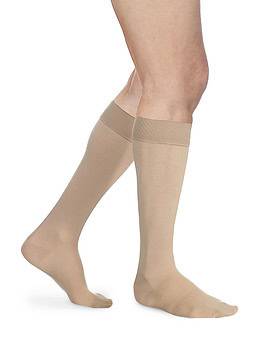Compression stockings are essential for many who need leg support, particularly for managing certain medical conditions. It can be frustrating when these stockings start to rip or tear. To help you maintain the longevity of your compression stockings, we have compiled a list of valuable tips and techniques.
Why Compression Stockings Can Rip
Compression stockings serve crucial roles for individuals with varicose veins or deep vein thrombosis. They apply pressure to the legs, promoting better blood flow and reducing swelling. However, like any other clothing item, they can rip or tear over time, which can be frustrating and costly.
Here are some of the most common causes of compression stocking rips:
- Improper sizing can place excessive pressure on specific areas, leading to tears, whether they are too loose or too tight.
- Sharp toenails or rough skin can also easily snag the delicate fabric.
- Improper handling, such as pulling them up too forcefully or using excessive force when washing, can contribute to ripping.
Compression stockings can lose their effectiveness if they are ripped, making them less capable of providing the necessary pressure to improve blood circulation. This can lead to increased swelling, pain, and discomfort. Ripped stockings are more likely to bunch up or slip down, reducing their therapeutic benefits.
Proper Handling and Care of Compression Stockings
 Proper handling and care are essential for keeping your compression stockings in top shape and preventing rips. Follow these tips to ensure your stockings last longer:
Proper handling and care are essential for keeping your compression stockings in top shape and preventing rips. Follow these tips to ensure your stockings last longer:
- Always handle your compression stockings with clean and dry hands to avoid transferring dirt or oils onto the fabric.
- Avoid pulling or tugging on the stockings excessively. Instead, gently roll them up or down your legs.
- Be cautious of sharp objects, such as long nails or jewelry, as they can easily snag or puncture the fabric. For added protection, consider wearing gloves when putting on or taking off your stockings.
Best Practices for Washing and Drying Compression Stockings
- Check the manufacturer’s instructions for specific washing guidelines. Generally, compression stockings should be hand-washed in lukewarm water using a mild detergent.
- Avoid using bleach or fabric softeners, as these can weaken the elastic fibers of the stockings.
- After washing, gently squeeze out excess water without wringing or twisting the stockings. Lay them flat on a clean towel to air dry, away from direct heat sources.
Tips for Storing Compression Stockings to Prevent Rips
- Store your compression stockings in a clean, dry place away from direct sunlight or extreme temperatures.
- Avoid folding or crumpling the stockings, as this can cause creases that may lead to rips or tears. Instead, consider rolling them up and placing them in a dedicated storage bag or drawer.
- Keep your compression stockings separate from other clothing items or accessories that could snag or damage them.
By following these guidelines for proper handling, washing, drying, and storage, you can extend the lifespan of your compression stockings and minimize the risk of rips or tears.
Avoiding Common Mistakes
Avoiding common mistakes that can lead to rips and tears is essential. By following these tips, you can ensure that your stockings last longer and provide you with the support you need.
Mistake #1: Not being careful
When putting on or removing your compression stockings, it is essential to handle them with care to prevent accidental damage. Avoid pulling or tugging on the stockings forcefully. Instead, take your time and gently roll them up or down your legs.
Mistake #2: Not maintaining your nails
Taking care of your nails is essential to prevent accidental damage. Long or sharp nails can easily snag and tear the fabric of the stockings. Make sure to trim your nails regularly and file any rough edges to avoid damaging your stockings.
Mistake #3: Wearing your compression stockings during intense activities
If you are participating in activities that involve a lot of movement or contact, such as gardening or playing sports, it is best to remove your stockings to prevent accidental damage. Additionally, avoid wearing shoes that are too tight or have rough edges that could rub against the stockings.
There are also some common misconceptions about compression stockings and rips. Contrary to popular belief, compression stockings are not indestructible. While they are designed to be durable, they can still rip if not appropriately handled. Treating them with care and following the manufacturer’s instructions for proper use and maintenance is essential.
By following these tips and regularly assessing the condition of your compression stockings, you can ensure their longevity and effectiveness in providing the support you need. Remember to consult your healthcare professional for specific recommendations based on your needs.
Disclaimer: Important Notice Regarding Medical Advice
The information provided in this blog is intended for general informational purposes only and should not be considered a substitute for professional medical advice, diagnosis, or treatment.

